Versuchen Sie, das Problem „Error too many redirects“ auf Ihrer WordPress-Website zu beheben?
Es handelt sich um einen häufigen WordPress-Fehler, der durch ein Plugin oder falsche Einstellungen verursacht werden kann. Er führt jedoch dazu, dass Benutzer von ihren WordPress-Websites ausgesperrt werden, was ihn besonders lästig macht.
In diesem Artikel zeigen wir Ihnen, wie Sie das Problem „Fehler zu viele Weiterleitungen“ in WordPress leicht beheben können. Wir zeigen Ihnen auch, wie Sie den Zugriff auf Ihre Website wiederherstellen und den Fehler beheben können.

Was ist die Ursache für den Fehler „Zu viele Weiterleitungen“ in WordPress?
Der Fehler „Zu viele Weiterleitungen“ wird durch eine falsch konfigurierte Weiterleitung in WordPress verursacht.
Wie Sie vielleicht bereits wissen, verfügt WordPress über eine SEO-freundliche URL-Struktur, die die Weiterleitungsfunktion nutzt. Auch viele beliebte WordPress-Plugins nutzen diese Funktion, um temporäre Weiterleitungen einzurichten, permanente 301-Weiterleitungen zu erstellen und 404-Fehler zu beheben.
Wenn Sie ein Plugin verwenden, um das Problem der unsicheren SSL-Inhalte zu beheben, oder ein WordPress-Caching-Plugin, dann kann dies auch Weiterleitungen beeinflussen und den Fehler „zu viele Weiterleitungen“ verursachen.
So sieht die Meldung „ERR_TOO_MANY_REDIRECTS“ in Google Chrome aus.
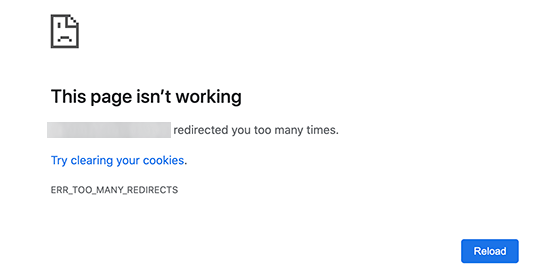
Dieser Fehler sagt Ihnen jedoch nicht, was den Konflikt verursacht und die Umleitungsschleife in WordPress erzwingt.
So sieht der Fehler in Firefox aus, mit der Meldung „Die Seite wird nicht richtig weitergeleitet“.
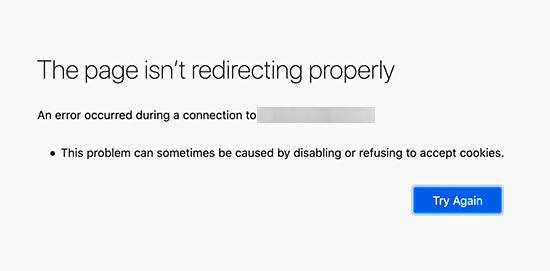
Schauen wir uns also an, wie man den Fehler „zu viele Weiterleitungen“ in WordPress beheben kann.
Wir führen Sie Schritt für Schritt durch die Fehlersuche, verschaffen Ihnen Zugang zu Ihrer WordPress-Website und verhindern, dass der Fehler erneut auftritt.
Video-Anleitung
Wenn Sie eine schriftliche Anleitung bevorzugen, dann lesen Sie einfach weiter.
1. Browser-Cookies und Cache löschen
Eine häufige Ursache für den Fehler könnten die Cookies Ihres Webbrowsers sein. Versuchen Sie, Ihre Website mit einem anderen Webbrowser wie Firefox, Safari, Opera oder Microsoft Edge aufzurufen.
Wenn Sie mit einem anderen Browser normal auf Ihre Website zugreifen können, müssen Sie die Cookies und den Cache in Ihrem normalen Browser löschen.
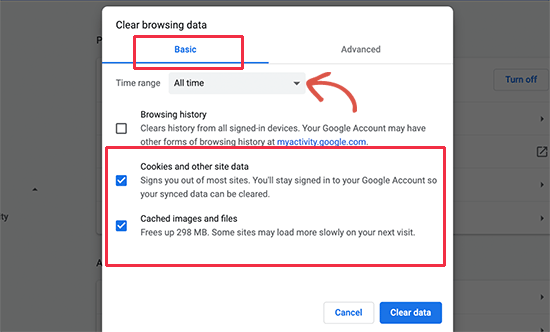
Wir haben eine detaillierte Anleitung, wie Sie Ihren Browser-Cache in allen gängigen Browsern leeren können, die Ihnen dabei helfen wird.
Wenn der Wechsel des Browsers das Problem jedoch nicht behebt, können Sie zum nächsten Schritt übergehen.
2. Deaktivieren Sie alle WordPress-Plugins
Die häufigste Ursache für WordPress-Weiterleitungsschleifen oder „ERR_TOO_MANY_REDIRECTS“ ist ein Plugin-Konflikt. Ein WordPress-Plugin, das versucht, eine Weiterleitung in einer Weise einzurichten, die mit den Standard-WordPress-Weiterleitungen in Konflikt steht, kann diese Fehlermeldung verursachen.
Um dies zu beheben, müssen Sie alle WordPress-Plugins auf Ihrer Website deaktivieren. Normalerweise können Sie einfach auf die Seite Plugins “ Alle Plugins im WordPress-Administrationsbereich gehen und Plugins von dort aus deaktivieren.
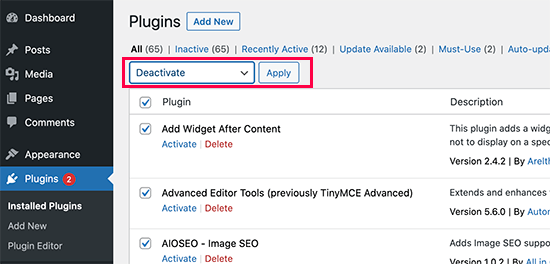
Wir gehen jedoch davon aus, dass Sie aufgrund des Redirect-Fehlers nicht auf den WordPress-Adminbereich zugreifen können.
In diesem Fall müssen Sie die WordPress-Plugins mit einem FTP-Client wie FileZilla oder der Dateimanager-App in Ihrem WordPress-Hosting-Kontrollpanel deaktivieren.
Verbinden Sie sich einfach mit einem FTP-Client mit Ihrer Website und gehen Sie zum Ordner /wp-content/.
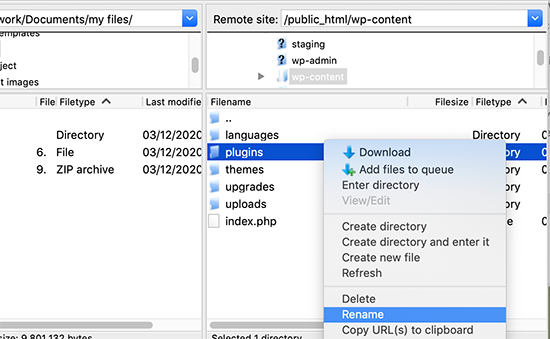
Dort finden Sie den Ordner “ plugins", den Sie in „plugins.deactivate“ umbenennen müssen.
Auf diese Weise werden alle WordPress-Plugins auf Ihrer Website deaktiviert.
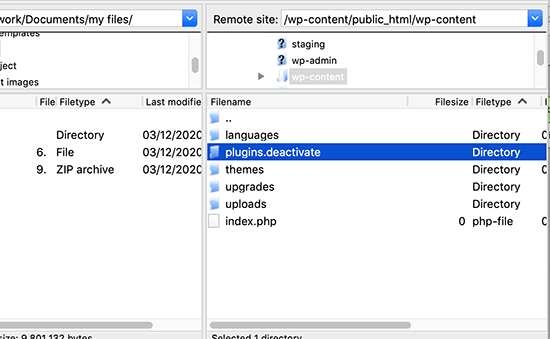
Grundsätzlich sucht WordPress nach einem Ordner namens plugins, um die Plugin-Dateien zu laden. Wenn es den Ordner nicht findet, deaktiviert es automatisch die aktiven Plugins in der Datenbank.
Jetzt können Sie versuchen, Ihre WordPress-Website zu besuchen. Wenn Sie sich jetzt in Ihren WordPress-Administrationsbereich einloggen können, bedeutet dies, dass eines der Plugins den Fehler verursacht hat.
Um herauszufinden, welches Plugin der Übeltäter war, müssen Sie zurück zum FTP-Client oder zur Dateimanager-App wechseln und den Ordner plugins.deactivate wieder in „plugins“ umbenennen.
Wechseln Sie danach in den WordPress-Verwaltungsbereich Ihrer Website und gehen Sie auf die Seite Plugins “ Alle Plugins. Von hier aus können Sie Ihre Plugins eines nach dem anderen aktivieren und dann Ihre Website besuchen, um zu sehen, ob Sie den Fehler reproduzieren können.
Sobald Sie das Plugin gefunden haben, das den Fehler verursacht, können Sie eine Alternative zu diesem Plugin finden oder das Problem im WordPress-Supportforum des Plugins melden.
3. WordPress-URLs korrigieren
Eine weitere Hauptursache für diesen Fehler ist eine Fehlkonfiguration in den WordPress-URL-Einstellungen. Normalerweise können Sie diese Optionen auf der Seite Einstellungen “ Allgemein einsehen.
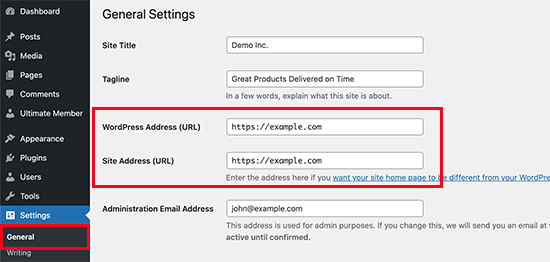
Bei den meisten Websites müssen die URLs in den Feldern „WordPress-Adresse“ und „Website-Adresse“ identisch sein. Manche Benutzer verwenden jedoch in einer URL „www“ und in der anderen eine Nicht-WWW-URL.
Da Sie möglicherweise keinen Zugriff auf den WordPress-Verwaltungsbereich haben, müssen Sie die WordPress-URLs mit einem FTP-Client oder der Dateimanager-App korrigieren.
Verbinden Sie sich einfach mit einem FTP-Client mit Ihrer WordPress-Website und gehen Sie zu /wp-content/themes/ihr-theme-ordner/.

Von hier aus müssen Sie die Datei functions.php finden und sie mit einem einfachen Texteditor wie Notepad oder TextEdit bearbeiten.
Als Nächstes müssen Sie den folgenden Code am Ende hinzufügen:
update_option( 'siteurl', 'https://example.com' );
update_option( 'home', 'https://example.com' );
Vergessen Sie nicht, „https://example.com“ durch die URLs Ihrer eigenen Website zu ersetzen. Sie können nun Ihre Änderungen speichern und die Datei wieder auf Ihre Website hochladen.
Versuchen Sie danach, Ihre Website zu besuchen, um zu sehen, ob der Fehler dadurch behoben wird.
Weitere Methoden finden Sie in unserem Tutorial, wie Sie WordPress-URLs einfach ändern können.
4. WordPress .htaccess-Datei zurücksetzen
Die .htaccess-Datei ist eine spezielle Datei, die vom Website-Server zur Verwaltung von Weiterleitungen und anderen Servereinstellungen verwendet wird. WordPress verwendet diese Datei auch für SEO-freundliche URLs und andere Weiterleitungen.
Manchmal können WordPress-Plugins Änderungen an der .htaccess-Datei Ihrer Website vornehmen, die diesen Fehler auslösen können. Es ist auch möglich, dass das Deaktivieren eines Plugins diese Änderungen nicht aus Ihrer .htaccess-Datei entfernt.
In diesem Fall müssen Sie Ihre WordPress-.htaccess-Datei manuell zurücksetzen.
Auch hier müssen Sie mit einem FTP-Client oder der Dateimanager-App in Ihrem Hosting-Dashboard auf Ihre Website zugreifen. Sobald Sie verbunden sind, sehen Sie die .htaccess-Datei im Stammverzeichnis Ihrer Website.
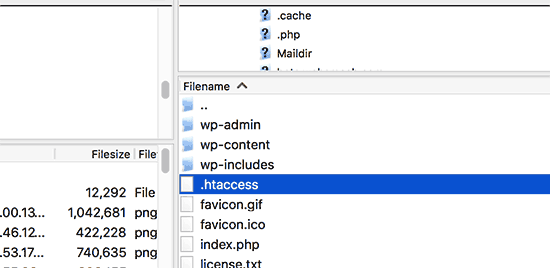
Hinweis: Wenn Sie Ihre .htaccess-Datei nicht finden können, lesen Sie unsere Anleitung, wie Sie die .htaccess-Datei in WordPress finden.
Zunächst müssen Sie eine Kopie Ihrer .htaccess-Datei auf Ihren Computer herunterladen, um sie zu sichern. Danach können Sie die Datei von Ihrer Website löschen.
Sie können nun versuchen, Ihr WordPress-Blog zu besuchen. Wenn alles normal funktioniert, bedeutet dies, dass Ihre .htaccess-Datei den Umleitungsfehler verursacht hat.
Da wir die .htaccess-Datei gelöscht haben, müssen Sie sie jetzt neu erstellen. Normalerweise kann Ihre WordPress-Website dies selbst tun. Um sicherzugehen, gehen Sie einfach auf die Seite Einstellungen “ Permalinks und klicken Sie auf die Schaltfläche „Änderungen speichern“ am unteren Rand.
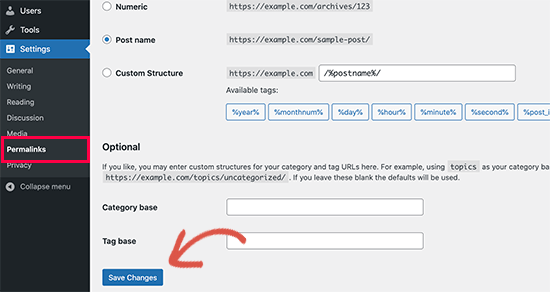
5. Fehlervermeidung bei zu vielen Weiterleitungen in WordPress
Hoffentlich haben die soeben beschriebenen Schritte das Problem der Weiterleitung auf Ihrer Website behoben. Wenn sie das Problem nicht behoben haben, müssen Sie möglicherweise mit Ihrem WordPress-Hosting-Unternehmen sprechen, um sicherzustellen, dass es kein Serverproblem gibt.
Sobald das Problem auf Ihrer Website behoben ist, sollten Sie auch in der Lage sein herauszufinden, was die Ursache ist.
Wenn es ein Plugin war, müssen Sie das Problem im Support-Forum des Plugins melden. Siehe unseren Leitfaden, wie Sie WordPress-Support anfordern. Wenn Sie jedoch keine Hilfe bekommen können, können Sie immer ein alternatives Plugin finden, das dasselbe tut.
Wenn der Fehler durch eine Fehlkonfiguration der WordPress-Site verursacht wurde, können Sie sich dies notieren und sicherstellen, dass Ihre Site-Einstellungen richtig eingerichtet sind.
Weitere Tipps finden Sie in unserer ausführlichen Anleitung zur Fehlerbehebung bei WordPress-Problemen, die Sie selbst durchführen können.
Wir hoffen, dass dieser Artikel Ihnen geholfen hat, das Problem „Fehler zu viele Weiterleitungen“ auf Ihrer Website zu beheben. Vielleicht möchten Sie auch ein Lesezeichen für unser ultimatives Handbuch der häufigsten WordPress-Fehler setzen und sich unsere Liste der besten WordPress-SEO-Plugins und -Tools ansehen.
Wenn Ihnen dieser Artikel gefallen hat, dann abonnieren Sie bitte unseren YouTube-Kanal für WordPress-Videotutorials. Sie können uns auch auf Twitter und Facebook finden.





Syed Balkhi says
Hey WPBeginner readers,
Did you know you can win exciting prizes by commenting on WPBeginner?
Every month, our top blog commenters will win HUGE rewards, including premium WordPress plugin licenses and cash prizes.
You can get more details about the contest from here.
Start sharing your thoughts below to stand a chance to win!
David Najman says
Hi,
I had this error on the product tag page. I tried all the possible repairs mantioned above with no luck.
Finally, I had to rename slug for tags not to be numbers, eg. 2016, so I renamed it to r2016 and it started to work!
It must have been caused by some wordpress update, because it have been working few years before with tags named as numbers.
WPBeginner Support says
Thanks for sharing what worked for you, if your product page is created by a plugin you may want to try reaching out to the plugin’s support to let them know about that issue
Admin
Yavan Kumar says
Hi,
My whole website is running properly, but the homepage is redirected too many times and same issue with the wp-admin page too. I tried all the methods you mentioned but nothing worked for me.
Please advice me if there is any another solution for that.
Thanks in advance…
WPBeginner Support says
If none of the methods from the article worked, you would want to reach out to your hosting provider for them to see if there are any issues they can see on their end.
Admin
John Zoetebier says
My web site is a Bitnami WordPress deployment on Google Cloud Platform.
When I use:
define(‚WP_SITEURL‘, ‚http:/example.cloud‘);
the home page gets redirected to itself and browsers error message.
I now use the original Bitnami setting and it works great !
define(‚WP_SITEURL‘, ‚http://‘ . $_SERVER[‚HTTP_HOST‘] . ‚/‘);
WPBeginner Support says
You are missing a slash next to your http in the first define statement but thank you for sharing your workaround.
Admin
Chad says
I had to desactivate a plugin and it worked back fine. I identified the plugin to desactivate by looking into my URL where I was getting a redirect error. The plugin name was written there.
WPBeginner Support says
Thanks for sharing how you found the error for others trying to solve this problem
Admin
Nirav Patel says
Thanks you bro for information of wp error
WPBeginner Support says
Glad our article could help
Admin
irga says
yeah, you know,,, i searching for it,,,,, and then mys wordpress site working again, thanksfull
Rahul says
Thans buddy , really helps
Josh says
I’ve tried all the steps here with no luck today. Luckily my website is functioning ok but I can’t log into the wp-admin dashboard for anything.
What are the other options? There must be other ways I can figure out what’s causing it?
Deby says
I’m having the same. My site works fine for visitors, but I only get the redirect error for the backend, my WP dashboard.
It’s a new site and I don’t even have any plugins installed yet. I’m stumped.
Bryant Thomas says
Holy Cow That worked, I’ve done many websites migrations and never ran into this issue. Thank you the define(‚WP_HOME‘,’http://example.com‘);
define(‚WP_SITEURL‘,’http://example.com‘); worked with the www.
Rutvi Trivedi says
Hi, My problem is when I go to my site’s dashboard(/wp-admin) it is giving me this error I tried this solution and unfortunately it is not working. Please help me to solve this error.
Shakeane says
I just want to say thank you so much for sharing this knowledge, you wouldn’t understand how much this has helped me, something as minor is adding www or leaving the forward slash at the end has caused so many headaches, thank you so much.
Marc says
Awesome! Only took 5 minutes and fixed!!!
hassan says
dear sir,
i have huge data on my website i change my address directly from http://www.example.com to example.com i remove www from wp-confiq and phpmyadmin without doing the above procedure, now i update all the plugin and theme everything is fine but my theme setting is not editing when i am going to change setting of my theme the changes reverting …please help how to solve this problem i will be thankful to you
i am trying to solve this problem from three days but fail
please help
Sachin says
Hi, my website is running without any error but i have this issue in backend when i open appearance>customize tab. I am unable to customize my website from backend. How can i solve it?
Adrian Daniels says
Wow, this actually worked, thanks!!
Toheeb says
Hi!
Thank you for your post…
I was able to solve mine changing the WP_SITEURL and WP_HOME to lowercase letters. I capitalized each word formerly for readability and as it turned out, it redirects post paginated pages.
Everything seems fine now. Thank You
Laurena says
Hey, this was my problem! Thanks for your comment here.
scott says
This was my problem as well.
Karla says
This was my problem too! Thanks for your comment! I tried everything in the video but nothing worked.
Rudy Reteig says
I made a redirect in ADDOn Domain to rid my site of a tail, „/blog“, behind my URL, appeared when launched the site. This was in my opinion automatically done, as I have two sites on the same PUBLIC_html directory. probably to avoid conflict of files with the same name of the two sites
Robin says
None of these fixes worked for me. In the end it turns out I had setup a custom page rule in CloudFlare a long time ago to treat the wordpress dashboard different to the rest of the site. It had „SSL – Flexible“ set which causes the error. I just set the rule to „Full“ and it works fine again.
Ada says
This was the fix for me. Thank you so much!
Damien says
Oh God! Thank you so much
Daniel says
Thanks a lot for this fix, after like 5 hours on this error, finally solved the issue. I spend more time on fixing errors than building website with wordpress. I’m tired
Simon says
Thanks bro. Hours of checking .htaccess etc and its just a simple cloudflare problem.
Rares says
This was the solution for me too. Thank you so much for sharing!
Jack says
This fixed mine! Thanks!
Jeenie says
Same here – once „Flexible“ was changed to „Full“ in the Cloudflare SSL settings, it worked! Phew. (Wish I saw your comment sooner!)
Nancy says
Thank you soooooo much for this! It worked.
Florian says
I also had the problem, so I started searching for a solution and found out that the CDN was causing that error. I switched it off and it worked again
Jennifer says
Thank God I saw your reply. I thought because I had added the Yoast SEO plugin, it was causing the issues, but I had also activated CDN in my control panel and that was the problem!
Alex Jr says
I deactivated all plugins, disabled the current theme, deleted .htaccess, but I’m still getting the „too many redirects“ error when I try to access my wordpress site. What is causing it and how can I fix it?
Dan says
Just had this happen to me on a new site I’m working on. The issue turned out that I created my child theme with spaces in the name. As soon as I renamed the child theme folder to my-child-theme it worked. I did have to go and make my child theme active again to make it work right. Hope this saves someone so grief and aggravation!
ANA says
Dan, I just wanted to say THANK YOU!!!!!!!
That was my problem too, apparently. I changed the name and folder to include a dash and everything works fine.
Santiago says
I’m finding that when I try to set my Permalink to Post Name I get the redirect issue. When I set it to Plain, no issues. I’ve disabled all the plugins and still the same thing.
I’m new to WP but 20+ years IT, any help would be greatly appreciated.
Damion says
+1 on this and thank for for so thoroughly and generously sharing your knowledge – you saved me hours of work today.
Bilal Asghar says
This is a really helpful article. I had the redirection issues with my WordPress website. I just changed my Post URLS going to Setting>Permalinks.
Ebad Ur Rehman says
My site is redirected too many time in the preview of customization
other functions of theme are working fine.
please tell the solution for the problem
Sharon Booker says
Thank you so much. I called my hosting service help desk twice and nothing they told me to do helped. This fixed the error.
Amit Khandelwal says
I’m getting „ERR_TOO_MANY_REDIRECTS“ problem only on website Home page but other pages working fine. I think plugin „Redirection“ create this problem but it’s my need to keep activate this.
Please suggest.
Tenzin Nima says
Thank you so much!! I have been looking for solution for whole day and finally solved it.
Thank you
maria says
ive tried the first option, Settings » General and changed the url. the thing is, i accidentally put a ; instead of a . on the adress.
Now the site is all messed up and i cant even login on the admin user anymore, to change it back :/ any tips?
WPBeginner Support says
Hi Maria,
You can fix this by adding this code to your WordPress site’s wp-config.php file.
define('WP_HOME','http://example.com'); define('WP_SITEURL','http://example.com');1-click Use in WordPress
Don’t forget to replace example.com with your own domain name.
Admin
Yildirim says
hi,
what about https
WPBeginner Support says
The code is example code, if you are using https then you would put https in the code
Em Walker says
Hi, Every time I go to the WIDGET page to load my adsense ads then my page freezes up and becomes unresponsive, how can I fix this, please
Mark says
Thank you that worked
Abiskar Bharati says
I tried all the things mentioned in the blog but issue still persisted so I did what Jake Philips(one of the comment above) did and I found that something had changed the permalink structure setting to:
/’/%year%/%monthnum%/%day%/%postname%/’
I changed it back to (as the comment suggests) :
/%year%/%monthnum%/%day%/%postname%/
and then everything was working fine again…
Abhishekh Maharjan says
Thank You. It worked
Cindy says
When I put my link on Facebook my photo that’s on my webpage does not come up just my website name and URL. Any idea what I need to do to have a thumbnail photo?
Felix says
Hi, CINDY.
That’s because you didn’t use Yoast plugin, and didn’t set the rules on Facebook tab. The issue is related to open graph protocol.
Khori Carnes says
Hi. I am having a some what odd issue, i feel. My redirect issue is that when i attempt to access my wordpress admin page using my domain, it redirects me to godaddy.com. my only explanation I can come up with is that i purchased my domain name from godaddy. However i purchased my web hosting from hostgator. Regardless, i can not access my admin page for wordpress to begin establishing my new website.
Any and all help or suggestions would be greatly appreciated! Thanks
WPBeginner Support says
Hi Khori,
You can contact GoDaddy support and they can help you point out your domain name to your hosting provider. All you need to do is go to your GoDaddy account and point Name Server settings for your domain name to HostGator.
Admin
Ralf says
In my case the problem was special characters in the URL. You can’t have those with wordpress. E.g. German umlauts: ÄÖÜ – need to be converted.
Teemu says
Yes and no. I succesfully ran a website with „ä“ character in there for a few years. But this time this might be the reason why I’m searching help to this problem here with a website that now has the same „ä“ character there also…
Don Stewart says
I panicked when I could not access my website home screen (though I could the other pages). I messed around with the Settings=>General URL settings, and I saw that the same address appeared as the WordPress URL and the website URL—which meant it was going around in circles, as you pointed out. I fiddled with that for awhile, almost locking myself out of WordPress altogether, but then deactivated several recently installed plugins. Fixed! I’m not sure which plugin caused it—I will investigate that, by omitting the one I think is most likely and one-by-one reactivating the others, but my suggestion is to follow your article from the bottom up. Check out those recent plugins!
Jake Phillips says
I had just enabled CDN and SSL in Bluehost for my WordPress site when this started happening. I found that something had changed the permalink structure setting to:
/’/%year%/%monthnum%/%day%/%postname%/‘
I changed it back to:
/%year%/%monthnum%/%day%/%postname%/
and then everything was working fine again…
Asma says
Hi,
Your article is really good and may be a solution of my recent problem. But I am not a WordPress expert and not enough brave to experiment with my site, though the blog is completely built by myself.
However, I’m seeing the following things from last two days–
„This page isn’t working
m redirected you too many times.
Try clearing your cookies.
ERR_TOO_MANY_REDIRECTS“
I’ve tried many times after clearing cookies, still, I can’t log into my site.
Can you please give a solution?
WPBeginner Support says
Hi Asma,
If you have tried steps mentioned above, then you can try our WordPress troubleshooting guide. It will help you figure out what’s causing the issue and how to fix it.
Admin
Adeshola says
My problem seemed to be a mixture of plugins and wp-config.php. After deactivating my plugins, I was able to access my site but not my wp-admin area. I fixed this by updating my wp-config with the codes provided above. However, they worked only after I put them before the „/* That’s all, stop editing! Happy blogging. */“ line. This was something you guys didn’t include in your tutorial but I found somewhere else. So thanks for everything. My site works now.
George says
Just wanted to say this article helped me a great deal… Here’s my case:
WP installed in a directory: domain.com/widget
domain.com .htaccess edited for SEO purposes to say
DirectoryIndex /widget/index.php /widget/
This caused the „too many redirects“ issue. Possibly because of the trailing slash in the domain.com .htaccess file??
Anyway, this fixed it:
domain.com .htaccess edited to:
DirectoryIndex /widget
Now it works.
Huzzay for cPanel!!!
Mirjam says
My issue is that trying to access the login page keeps giving me a redirect to https:// but my site is in http://. Have tried everything, adding home url to config.php, disabling plugins, renewing .htaccess. There is no redirect defined in CPanel so I’m lost as to why this is happening. The site is available, but I cannot access admin.
Getting a bit hopeless here…
WPBeginner Support says
Please contact your WordPress hosting provider, they may be able to help you out.
Admin
Gilbert Stawny says
If none of the above works, rename your .htaccess file to htaccess.old or something. Try to log in again.
Talha Wahid says
Thanks a lot, Finally i solve it by spending whole week. only adding to the wp-config.com
define(‘WP_HOME’,’http://example.com’);
define(‘WP_SITEURL’,’http://example.com’);
Adrian says
One way that you can create the infinite redirect loop is to set WordPress Address and Site Address using camel case, MyExampleWebsite.com for example . The domain part of a URI is supposed to be case-insensitive, the file part has to be case sensitive to cope with case-sensitive file systems. WordPress breaks if you use camel-case.
Adnane says
I had the same problem, solved it by going to cpanel then look in the security tab if there is mod security , if yes deactivate it.
That was it for me.
Howard Bussey says
Thank you for writing this. I set up redirection with Easy HTTPS Redirection, and ran into the „too many redirections“ problem. I solved it by turning off a property in Woo Commerce. In the checkout settings, I had both „force secure checkout“ and „force HTTP when leaving the checkout“ selected. I unselected the „force HTTP when leaving the checkout“, and no longer see the „too many redirections“ problem. I didn’t have to edit any .htaccess file.
Asser says
If the issue is happening only when accessing the admin control panel , then look at the wp-admin and check if there is htaccess file in place (www/wp-admin/.htaccess ) and if you find one then rename it and refresh the admin URL (example.com/wp-admin/) and it should work .
Suraj says
Simply superb, this resolved the redirect loop issue I was facing, thanks a lot, appreciate the article
Akash Gadiya says
Hi, I’ve tried all the troubleshooting options here but nothing seems to work. The last thing I remember doing was to take a full backup using the Backup Wizard on the cPanel. Could that in any way lead to this error (Too many redirects)
Here’s a list of what I’ve done so far to fix this issue:
1) Removed the backup file from the root directory
2) Edited the wp-config file by adding those 2 lines of code, both with and without www
3) Deleted the .htaccess files from the root directory and wp-content folder one at a time
4) Scanned through all the comments to see if there is any possible solution, to no avail
I have sought for the help of the root admin, hopefully we’d be able to fix this ASAP. If you think I’ve missed out on anything or could try anything apart from these, please do let me know.
Thanks
Akash
Akash Gadiy says
I could finally fix the problem. It had something to do with the backend I guess. My admin reset the server and that breathed life into my website again. Thanks for this post though. Good luck to all trying to fix this problem. May the force be with you